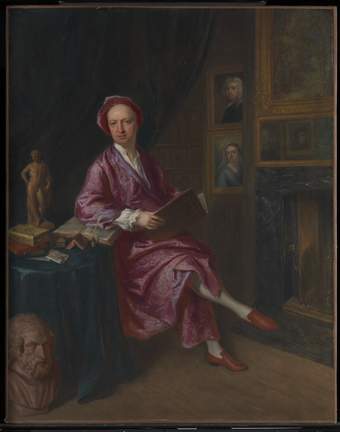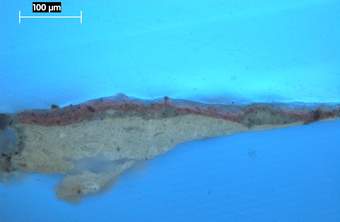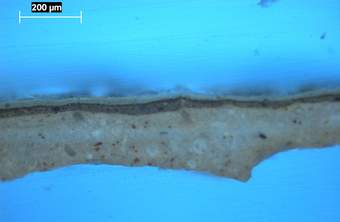
Fig.1
Jonathan Richardson
Portrait of the Artist's Son, Jonathan Richardson the Younger, in his Study c.1734
T13207

Fig.2
Reverse showing the original stretcher and the canvas adhered to the aluminium plate
The painting (fig.1) has a support of medium weight linen canvas with a tight, plain weave.1 Before acquisition and likely in the later twentieth century, it had been lined with a mixture of wax and resin, during which the tacking margins were cut off. This treatment has made the support very rigid. It is likely that the original six-membered stretcher (fig.2), its wood bevelled fully only on the outer edges, was reused, since the width of the stretcher bar members matches the crack pattern that has developed in the paint from canvas movements against the original stretcher bars. In the same treatment, a thin aluminium panel had been placed behind the lined canvas,2 and another canvas placed on top and adhered to the plate with wax by ironing, before the re-stretching.

Fig.3
Cross-section near the left edge, from the cover of the red book on the table, in ultraviolet light, showing varnishes sunk into the non-fluorescent pinkish glaze applied over opaque red underpainting applied to thin grey underpainting, over the thick, pale ground
The ground is a cream or biscuit colour, made from lead white with yellow ochre and a small amount of coarse bone black in oil medium. The medium and lead white have reacted chemically to form lead soaps which appear as rounded aggregates (fig.3): their abundant presence makes this layer, and hence the whole painting, look darker and more transparent.

Fig.4
Partial X-radiograph showing the feet and legs

Fig.5
Ultraviolet light shows a thick accumulation of vanish and many areas of retouching, which appear dark
Detail in the X-radiograph is compromised by the aluminium panel, but still makes it clear that the right foot has been re-positioned slightly higher (fig.4). The pentimento has resulted in some cracking in this area. There is extensive age cracking over the entire surface, with the cracks in the centre of the canvas beginning to form cups, and some fine diagonal cracks across the lower left corner, the result of keying out the canvas since it was re-stretched. The past treatment has prevented paint loss but has emphasised the visibility of the canvas weave and made the ageing cracks more noticeable, in addition to making the paint heat-sensitive, and creating a slight bulge near the feet, where some material must have been trapped on the aluminium plate. Some of the numerous retouches rendered obvious in ultraviolet light (fig.5) have been made to losses in the paint and ground without filling and levelling, resulting in depressions in the surface.

Fig.6
Cross-section from the left edge, photographed in ultraviolet light, showing thin mixed three brown paint layers used to depict the curtain, collectively much thinner than the ground, which can be seen here to have had three applications

Fig.7
Cross-section from the left edge, showing an intense blue glaze over a very thin opaque grey layer, for the blue tablecloth
The paint is well bound but thinly applied, mostly opaquely, with some areas glazed, in particular the pinkish red robe and the cap, which likely include madder, to judge by their fluorescence in ultraviolet light (fig.5). The red book on the table, for example, was painted (see fig.3) with a pink glaze made from a non-fluorescent red lake, likely carmine, applied to a bright and opaque layer of vermilion, over a pale grey underpainting, the combined paint layers all being much thinner than the ground layer. The dark brown curtain was painted with three layers of mid brown, dark brown and light brown, all thin and all including fine bone black and brown earth colours as well as lead white, the upper one glaze-like and including some natural resin (fig.6). The bright blue tablecloth was painted with a thin but intensely-coloured layer of Prussian blue in resin, now looking greenish in the cross-section (fig.7) because this resin has yellowed, over very thin but opaque mid grey paint made from lead white and bone black. There are a few lightly impasted highlights now flattened by the lining process.

Fig.8
The same cross-section, in ultraviolet light, showing several varnishes of natural resin type overlying the paint
It is likely that several varnishes are present, as can be seen in fig.8, the more recently applied ones being of natural resin type, with a synthetic varnish on top. This is Ketone N,3 a polycyclohexanone varnish which yellows on ageing, much as natural resin varnishes do, a type used mainly in the 1970s and 1980s. The varnishes appear milky with fine crazing, in addition to having yellowed.
Following acquisition, dirt was removed from the varnish surface and from the canvas on the reverse, while the bulge in the canvas was found to level off somewhat when the painting was maintained in a stable environment, rendering de-lining unnecessary. The yellowed varnishes and the aluminium plate are still present.
The frame was around the painting when it was acquired in 2010.4 It is nineteenth-century in origin, is a poor fit for the painting, and it has been modified in its decoration most likely during the twentieth century, perhaps to give it a more eighteenth-century appearance.
January 2019
